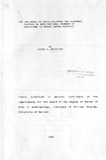| dc.description.abstract | Housing is a very important aspect of human existence. A multiplicity of factors such as vegetation, soils, climate, topography, culture and technology have some impact on houses. The impact of these factors may lead to changes in house-types. This study, taking a cross-sectional approach, surveys the influence of the sociocultural and economic factors on the evolution of the architectural form of houses in Mosop Division, Nandi District. Specifically, income, occupation, education, marital status and the household size are considered and statistically tested to determine their influence on the architectural form of houses.
Evaluations of these variables are made within the context of three theoretical positions: Cultural determinism as propounded by Amos Rapoport; cultural evolution as propounded by Leslie White and pattern theory of material culture as propounded by Ocholla-Ayayo.
The data utilized for the study were collected by a
variety of techniques, the principal ones being administration of a standardized questionnaire, interviews and direct observation.
Analysis of -the data by inferential statistical
techniques showed that occupation, income, and marital status are significantly related to the house-form.
The findings imply that the household head's economic, educational, occupational, and marital status influence house-types. This means that socio-economic progress is bound to have some influence on the development of building styles in an area.
The findings support the composite hypothesis that the socio-cultural and economic factors influence the house-type at varying statistical significance levels. The conclusion drawn,therefore,is that the socio-cultural and economic factors influence the architectural form of houses in Mosop.
Practical and academic implications of the findings are
assessed. The results suggest that the socio-cultural and economic factors should be strongly considered in the design of houses in the rura1 areas. Hence, house plans used in the rural areas should not necessarily be blue prints of houses originally designed for urban dwellers. | en |

